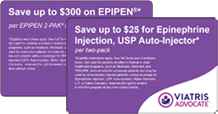
On this page:
Signs and symptoms
Involvement of body organ systems in anaphylaxis varies among patients, and even in the same patient from one allergic reaction to another. However, there are general patterns regarding organ system involvement and signs and symptoms associated with anaphylaxis.1-3
Most often, allergic reactions involve the skin (80%-90%) and the respiratory tract (70%).3,4 Less often, allergic reactions involve the GI tract (30%-45%), the cardiovascular system (10%-45%) and the central nervous system (10%-15%).3,4 See Table 1. Symptoms involving the throat, lungs or heart can potentially be life-threatening and should not be ignored. See Table 2.3,5
Table 1. Common Signs and Symptoms of Anaphylaxis3,5,6
| Skin | Airway* | Central Nervous System | Cardiovascular System* | GI Tract |
|---|---|---|---|---|
| 80-90% of reactions | 70% of reactions | 10-15% of reactions | 10-45% of reactions | 30-45% of reactions |
| Hives (urticaria), itching (pruritus), flushing | Larynx: pruritus and tightness in throat; dysphonia and hoarseness | Uneasiness, throbbing headache, dizziness, confusion, tunnel vision | Chest pain, hypotension, tachycardia, weak pulse, dizziness, fainting | Nausea, cramping, abdominal pain, vomiting, diarrhea |
| Mucosal tissue: pruritus and swelling of lips, tongue, uvula/palate | Lung: dyspnea, chest tightness, wheezing/bronchospasm |
*Potentially life-threatening symptoms.
Table 2. Major organs and symptoms implicated in anaphylaxis1,3
| Throat | Lung | Heart |
|---|---|---|
| Pruritus and tightness in the throat | Dyspnea | Chest pain |
| Dysphonia | Chest tightness | Hypotension |
| Hoarseness |
Wheezing/ bronchospasm |
Tachycardia |
| Weak pulse | ||
| Dizziness | ||
| Fainting |
Confirmation of anaphylaxis triggers
In patients who have experienced anaphylaxis, it is important to confirm the allergic trigger or triggers.3,6 A detailed history of prior exposures and resulting allergic reactions can identify specific allergic triggers that should be avoided in order to prevent recurrences of anaphylaxis.2,3,6
Determining the nature of the symptoms during previous anaphylactic reactions is also important. It is critical to ask the patient if there was2:
- Evidence of skin manifestations, particularly angioedema, flushing, pruritus or urticaria
- Upper or lower airway obstruction
- Nausea, vomiting, diarrhea or other GI symptoms
- Syncope/presyncopal symptoms
In addition to the patient’s history, several tests are available to help identify allergic triggers of anaphylaxis, including skin tests, in vitro tests and challenge tests.3 These tests are described in Table 3.
Table 3. Tests that confirm anaphylactic triggers
| Skin tests |
|---|
|
| In vitro tests |
|
| Challenge tests |
|
Anaphylaxis diagnosis criteria
The following diagnostic criteria (see Table 4) are likely to capture more than 95% of cases of anaphylaxis.9
Table 4. Clinical criteria for diagnosing anaphylaxis9
| Anaphylaxis is highly likely when any one of the following 3 criteria is fulfilled: |
|---|
|
Because the majority of anaphylactic reactions (>80%) include skin symptoms, it was judged that at least 80% of anaphylactic reactions should be identified by criterion 1—even when the allergic status of the patient and potential cause of the reaction are unknown. However, cutaneous symptoms might be absent in up to 20% of anaphylactic reactions in children with food or insect sting or bite allergy. Criterion 1. Acute onset of an illness (minutes to several hours) with involvement of the skin, mucosal tissue or both (e.g., generalized hives, pruritus or flushing, swollen lips/tongue/uvula) AND AT LEAST ONE OF THE FOLLOWING:
|
| In patients with a known allergic history and possible exposure, criterion 2 should provide ample evidence that an anaphylactic reaction is occurring. |
|
Criterion 2. Two or more of the following that occur rapidly after exposure to a likely allergen for that patient (minutes to several hours):
|
| Criterion 3 should identify the rare patients who experience an acute hypotensive episode after exposure to a known allergen. |
|
Criterion 3. Reduced BP after exposure to known allergen for that patient (minutes to several hours):
|
*Low systolic BP for children is defined as <70 mm Hg from 1 month to 1 year; < (70 mm Hg + [2 X age]) from 1 year to 10 years; and <90 mm Hg from 11 to 17 years. Adapted from Sampson et al, J Allergy Clin Immunol, 2006.
Identifying patients at risk for an anaphylactic reaction
Major risk factors for a recurrent anaphylactic reaction include a history of previous anaphylaxis, exposure to allergic triggers and atopy.2 However, the severity of previous allergic reactions is not always indicative of the severity of future reactions.2,6,10
There are factors that increase the risk of anaphylaxis, such as exposure to known allergens, as well as factors that may increase the risk of a severe anaphylactic reaction, such as concomitant diseases and medications that hinder a patient from recognizing the signs and symptoms of anaphylaxis.3 A complete description of these risk factors can be found in Tables 5 and 6.
Table 5. Factors that increase the risk of experiencing anaphylaxis3
| Allergens |
|---|
|
Exposure to certain allergens increases the risk of triggering an anaphylactic reaction for those who are allergic, including:
|
| Other factors |
|
Table 6. Factors that may increase anaphylaxis severity3
| Age |
|---|
|
| Comorbidities |
|
The following concomitant diseases are associated with an increased risk of a severe anaphylactic reaction:
In patients of any age, concomitant diseases hampering recognition of signs and symptoms of anaphylaxis may place patients at an increased risk of a more severe anaphylactic reaction. Such diseases include:
|
| Concurrent medication or chemical use |
|
In patients of any age, concurrent medications and chemicals hampering recognition of signs and symptoms of anaphylaxis may place patients at an increased risk of anaphylaxis. Such medications and/or chemicals include:
Medications that may increase the severity of anaphylactic reactions and make them more difficult to treat include:
|
Special Offers
Viatris offers Access and Savings Programs for eligible patients. See Terms and Conditions.
There’s only one recommended first-line treatment for anaphylaxis.
heading
Important Safety Information (the following information applies to both EPIPEN and its Authorized Generic)
EPIPEN (epinephrine injection, USP) 0.3 mg and EPIPEN JR (epinephrine injection, USP) 0.15 mg Auto-Injectors are intended for immediate administration as emergency supportive therapy only and are not intended as a substitute for immediate medical or hospital care. In conjunction with the administration of epinephrine, the patient should seek immediate medical or hospital care. More than two sequential doses of epinephrine should only be administered under direct medical supervision.
Rare cases of serious skin and soft tissue infections have been reported following epinephrine injection.
References
- Dinakar C. Anaphylaxis in children: current understanding and key issues in diagnosis and treatment. Curr Allergy Asthma Rep. 2012;12(6):641-649.
- Lieberman P, Nicklas RA, Randolph C, et al. Anaphylaxis—a practice parameter update 2015. Ann Allergy Asthma Immunol. 2015;115(5):341-384.
- Simons FE. Anaphylaxis. J Allergy Clin Immunol. 2010;125(2)(suppl 2):S161-S181.
- Simons FE. Anaphylaxis: recent advances in assessment and treatment. J Allergy Clin Immunol. 2009;124(4):625-636.
- Volcheck GW. Clinical Allergy: Diagnosis and Management. Rochester, MN: Mayo Foundation for Medical Education and Research; 2009.
- Simons FE, Ardusso LR, Bilὸ MB, et al; World Allergy Organization. World Allergy Organization guidelines for the assessment and management of anaphylaxis. World Allergy Organ J. 2011;4(2):13-37.
- Bousquet J, Heinzerling L, Bachert C, et al. Practical guide to skin prick tests in allergy to aeroallergens. Allergy. 2012;67(1):18-24.
- Johansson SG. ImmunoCAP specific IgE test: an objective tool for research and routine allergy diagnosis. Expert Rev Mol Diagn. 2004;4(3):273-289.
- Sampson HA, Muñoz-Furlong A, Campbell RL, et al. Second symposium on the definition and management of anaphylaxis: summary report—Second National Institute of Allergy and Infectious Disease/Food Allergy and Anaphylaxis Network symposium. J Allergy Clin Immunol. 2006;117(2):391-397.
- Boyce JA, Assa’ad A, Burks AW, et al. Guidelines for the diagnosis and management of food allergy in the United States: report of the NIAID-sponsored expert panel. J Allergy Clin Immunol. 2010;126(6):S1-S58.

This site is intended for US healthcare professionals.
If you are a patient, please check out our site for patients.

Prescribing Information
Please select from the following:

Patient Information
Please select from the following:



